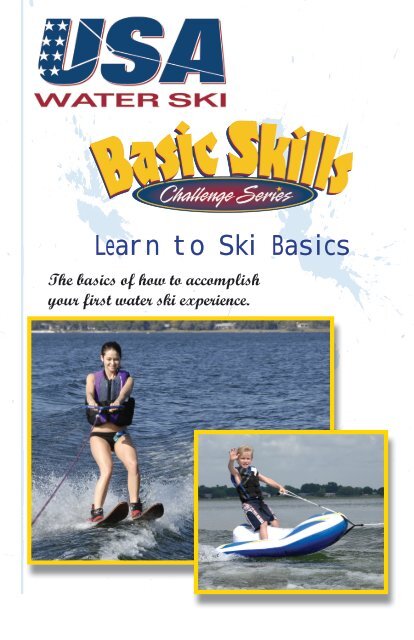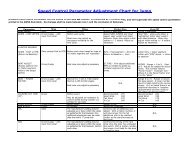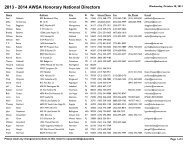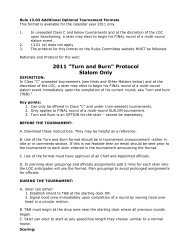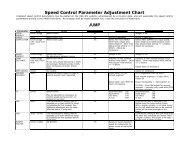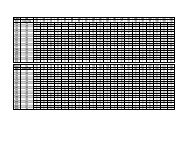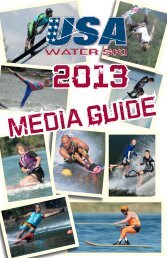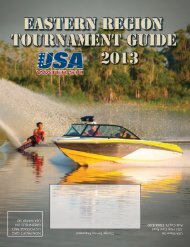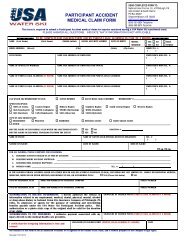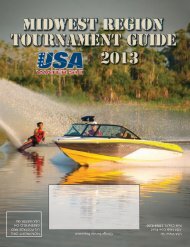You also want an ePaper? Increase the reach of your titles
YUMPU automatically turns print PDFs into web optimized ePapers that Google loves.
<strong>Learn</strong> <strong>to</strong> <strong>Ski</strong> <strong>Basics</strong><br />
The basics of how <strong>to</strong> accomplish<br />
your first water ski experience.<br />
<strong>USA</strong>WATERSKI.org (863) 324-4341
Level 1<br />
On land, demonstrate:<br />
The seven skier hand signals<br />
Placing feet in and adjusting bindings<br />
Holding the handle properly<br />
Proper body position for starting<br />
Proper body position while skiing<br />
Explain five of the 15 <strong>Ski</strong>er Safety Codes<br />
Important safety rule:<br />
Always wear flotation<br />
Hand Signals<br />
1 2 3<br />
4 5 6 7<br />
1. Speed up: The“thumbs-up” gesture indicates that the skier would like the speed increased.<br />
2. Slow down: The “thumbs-down” gesture indicates that the skier would like the speed decreased.<br />
3. OK: If the set speed or boat the path is good, the skier may use the OK signal.<br />
4. Turn: When either the skier or the driver wants the boat turned, a circle motion with the arm over the head with<br />
one finger in the air is used. It is usually followed by pointing in the direction of the turn.<br />
5. Back <strong>to</strong> the Dock: A pat on the head indicates that the skier would like <strong>to</strong> return <strong>to</strong> the dock.<br />
6. Cut Mo<strong>to</strong>r/S<strong>to</strong>p: A slashing motion with the hand across the neck indicates the boat is <strong>to</strong> s<strong>to</strong>p immediately. This<br />
signal can be used by the skier, driver or observer.<br />
7. I’m OK (after a fall): This important signal indicates that a skier is OK after a fall. It consists of both hands clasped<br />
over the head. It should be used every time the skier falls.<br />
<strong>Water</strong> <strong>Ski</strong>er’s Safety Codes<br />
Rule 1: Always wear flotation. A properly fitted<br />
personal flotation device is designed <strong>to</strong> fit snugly, so<br />
that it won’t slip up on the body during a fall. The<br />
recommended type is a jacket or vest that covers the<br />
chest, abdomen and back.<br />
Rule 2: Always be sure your equipment is in good<br />
condition. Your personal safety and enjoyment depend<br />
on the equipment you use. Check your equipment<br />
regularly. Be sure that your skis do not have sharp or<br />
protruding surfaces that could cut or scrape the skier.<br />
Check <strong>to</strong>wropes for frayed areas or broken bridles and<br />
handles. Repair or replace damaged or unsafe articles.<br />
Rule 3: Don’t give the starting signal until ready. Make<br />
sure you are ready, the slack has been taken out of<br />
the rope and you are clear of any dangerous obstacles<br />
around you. Keep your ski tips up.<br />
Rule 4: Do not ski near docks, pilings, other boats<br />
or swimmers. Always look ahead and be sure you are<br />
aware of your surroundings and where you are going at<br />
all times. Many water ski injuries result from collisions<br />
with docks or other solid objects.<br />
Rule 5: Never put any part of your body through the<br />
handle or wrap the line around yourself in any way.<br />
Rule 6: Never ski in shallow water or an area where<br />
there may be obstructions above or just beneath the<br />
surface.<br />
Rule 7: When a fall is inevitable, try <strong>to</strong> fall backward<br />
or <strong>to</strong> either side. A forward fall increases the chances of<br />
contact with the ski.<br />
Rule 8: Know and use the skier hand signals. It is<br />
particularly important <strong>to</strong> use the skier’s “I’m OK” signal<br />
after a fall if you are all right.<br />
Rule 9: If you fall in an area where there is other boat<br />
traffic, lift one ski half way out of the water. This will<br />
signal <strong>to</strong> other boats that there is a skier in the water.<br />
Rule 10: Never ski <strong>to</strong> the point of excessive fatigue.<br />
Rule 11: Always ski during daylight, from sunrise <strong>to</strong><br />
one-half hour after sunset.<br />
Rule 12: Never ski directly in front of another boat.<br />
Rule 13: Always use equal length ropes when skiing<br />
double.<br />
Rule 14: Always ensure that the mo<strong>to</strong>r is “off” when a<br />
skier is entering and exiting the boat.<br />
Rule 15: Always have an observer in the <strong>to</strong>wboat.<br />
<strong>USA</strong>WATERSKI.org (863) 324-4341
Placing Feet In Bindings And Adjusting<br />
How To Properly Hold The Handle<br />
For two skis, use the knuckles up grip; for one ski, use the baseball grip (with either hand up).<br />
Proper Body Position For Starting<br />
Demonstrate proper cannonball<br />
body position on land before<br />
entering the water <strong>to</strong> get the<br />
proper feel. Hold the handle and<br />
have a partner pull on the rope slightly<br />
<strong>to</strong> help pull you up. This will give you the feeling<br />
of being pulled up by the boat. While practicing<br />
this task, make sure your knees are <strong>to</strong>gether at<br />
all times, and stay in the cannonball position as<br />
shown in the picture. Let the boat do the work<br />
for you rather than trying <strong>to</strong> do the work yourself.<br />
Proper Body Position While <strong>Ski</strong>ing<br />
Initially remain in the chair position.<br />
This will ensure proper posture.<br />
You should have your arms straight,<br />
shoulders up and knees flexible. Once<br />
comfortable, bring your hips underneath<br />
your shoulders<br />
<strong>USA</strong>WATERSKI.org (863) 324-4341
Level 2 Two-<strong>Ski</strong> Starts<br />
Complete a deep-water start and maintain the proper two-ski body position for three seconds.<br />
Place the rope and handle between your skis. When ready, signal the driver<br />
<strong>to</strong> begin accelerating. Let the boat slowly pull you up. DO NOT try <strong>to</strong> pull<br />
yourself out of the water by pulling in with your arms. When you feel the<br />
boat begin <strong>to</strong> pull you up, slowly rise <strong>to</strong> a sitting position using your legs.<br />
Once up, maintain the proper body position of arms straight, knees bent and<br />
flexible, and keep your head up, looking <strong>to</strong>ward the boat.<br />
Practicing on land will speed the learning process<br />
IMPORTANT Level 2 Tip:<br />
Keep your Arms Straight,<br />
Knees Bent, Head Up<br />
Level 3 Two-<strong>Ski</strong> Balance<br />
Maintain proper two-ski body position for 20 seconds.<br />
Place emphasis on the proper two-ski body position: head up,<br />
arms straight and knees bent, and put some downward pressure<br />
on the handle.<br />
Approximate Weight<br />
Of <strong>Ski</strong>er<br />
Suggested Towboat Speeds<br />
Speeds are listed as a guide for the boat driver and will vary depending on<br />
the skiers experience and comfort level.<br />
Less than<br />
50 lbs.<br />
50 <strong>to</strong><br />
100 lbs.<br />
100 <strong>to</strong><br />
150 lbs.<br />
150 <strong>to</strong><br />
180 lbs.<br />
180 lbs.<br />
or more<br />
Two-<strong>Ski</strong> Speeds 13 mph 16 mph 18 mph 21 mph. 24 mph<br />
One <strong>Ski</strong> Speeds 16 mph 20 mph 24 mph 27 mph. 32 mph<br />
<strong>USA</strong>WATERSKI.org (863) 324-4341
Level 4 Two-<strong>Ski</strong> Steering<br />
Steer back and forth in control inside the wakes.<br />
Initiate each turn by putting more pressure on the inside edge of the ski opposite <strong>to</strong> the direction<br />
you want <strong>to</strong> go. Example, <strong>to</strong> turn right, lean slightly <strong>to</strong> your right and away from the boat and<br />
apply more pressure on your left ski.<br />
Releasing pressure on one foot while placing pressure<br />
on the other foot will allow you <strong>to</strong> go in the<br />
direction you want <strong>to</strong> go. For example: unweighting<br />
the left foot while placing pressure on the right foot<br />
will allow you <strong>to</strong> turn <strong>to</strong>ward the left wake.<br />
Level 5 Two-<strong>Ski</strong> Wake Crossing<br />
Cross over <strong>to</strong> the outside of the boat wakes on one side only and return <strong>to</strong> the<br />
center of the wakes.<br />
Cross the wakes by turning both skis at a sharp angle <strong>to</strong> the<br />
wakes and bend your knees <strong>to</strong> absorb the shock. Crossing one ski<br />
at a time with not enough angle will result in a fall.<br />
Try <strong>to</strong> cross the wake at an angle. Turn <strong>to</strong>ward the<br />
wake and keep pressure on the ski closest <strong>to</strong> the<br />
boat (furthest away from the wake) until you are<br />
well over the wake. Trying <strong>to</strong> go over the wake<br />
slowly will result in a fall.<br />
Level 6 Two-<strong>Ski</strong> Wake Crossing<br />
Leave the center of the boat wakes on<br />
one side and cross the wakes one time.<br />
The most common mistake for a skier is <strong>to</strong><br />
pull on the handle while crossing the wakes.<br />
Keep your arms straight, and knees bent and<br />
<strong>to</strong>gether. Continue <strong>to</strong> maintain<br />
the proper body position.<br />
Level 7 Two-<strong>Ski</strong> Wake Crossing<br />
Complete seven wake crossings in 60 seconds or less.<br />
Continue <strong>to</strong> emphasize<br />
proper body position.<br />
Congratulations! You have learned <strong>to</strong> water ski on two skis. You can find<br />
instruction on how <strong>to</strong> take the next step <strong>to</strong> skiing on a single ski in the<br />
<strong>USA</strong> <strong>Water</strong> <strong>Ski</strong> Basic <strong>Ski</strong>lls <strong>Learn</strong> To Slalom brochure.<br />
<strong>USA</strong>WATERSKI.org (863) 324-4341
Additional <strong>Learn</strong> To <strong>Ski</strong> Aids For The Young Beginner<br />
Aquaint the young beginner with the fun of gliding along the <strong>to</strong>p of the water<br />
Using an EZ <strong>Ski</strong> trainer makes it easy and fun for young children <strong>to</strong> learn <strong>to</strong><br />
water ski – the perfect prelude <strong>to</strong> learning on a pair of water skis.<br />
• Easy <strong>to</strong> board<br />
• Builds confidence<br />
• No fighting with rope or skis in the water<br />
• Immediate success and enjoyment<br />
The EZ <strong>Ski</strong> Teaches Basic <strong>Ski</strong>ing Fundamentals<br />
• Proper stance • Balance • Weight Shift for turning • Handle position<br />
Steady the EZ <strong>Ski</strong> when the child climbs<br />
aboard. It is easy <strong>to</strong> board from the swim<br />
platform, when alongside the boat or from<br />
the water.<br />
Pull the child across the water by hand <strong>to</strong> get<br />
him/her used <strong>to</strong> the feeling of motion.<br />
The child can sit or stand on the EZ <strong>Ski</strong><br />
whichever feels more comfortable.<br />
Hold the rope in your hand - do NOT fasten<br />
<strong>to</strong> the boat. Release the line in case of a fall.<br />
Speed for the EZ <strong>Ski</strong><br />
Trainer should be no<br />
more than 10 m.p.h.<br />
Slowly increase the speed up <strong>to</strong> 10 m.p.h. Slow<br />
when crossing wakes. Avoid sharp turns.<br />
<strong>USA</strong>WATERSKI.org (863) 324-4341
Tubing<br />
Riding in a dtube can be a very positive experience for a young child and non-athletic older<br />
children including teenagers. To ensure that the tube rider has a positive initial tubing experience<br />
certain safety precautions must be observed. Drive a gently curving boat pattern at a<br />
speed of 10-15 mph for young beginners. Do NOT use excessive speed or drive in an erratic<br />
pattern in an effort <strong>to</strong> throw the child off the tube.<br />
FUN for two!<br />
Caution, excess speed is<br />
likely <strong>to</strong> scare a young<br />
first- time rider.<br />
Two can go at the same time.<br />
Caution, excess speed is<br />
likely <strong>to</strong> casue injuries.<br />
<strong>USA</strong>WATERSKI.org (863) 324-4341
Congratulations!<br />
You have learned <strong>to</strong> water ski!<br />
You can find instruction on how <strong>to</strong> take the next step <strong>to</strong> skiing on a<br />
single ski in the <strong>USA</strong> <strong>Water</strong> <strong>Ski</strong> Basic <strong>Ski</strong>lls <strong>Learn</strong> To Slalom brochure.<br />
<strong>USA</strong>WATERSKI.org<br />
For additional information, go <strong>to</strong><br />
<strong>USA</strong>WATERSKI.org or contact us at:<br />
<strong>USA</strong> <strong>Water</strong> <strong>Ski</strong><br />
1251 Holy Cow Road<br />
Polk City, Fla. 33868<br />
Phone: (863) 324-4341<br />
E-mail: grassroots@usawaterski.org<br />
(863) 324-4341


